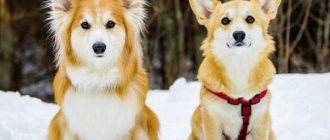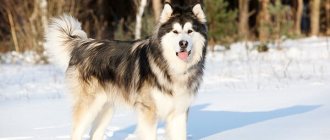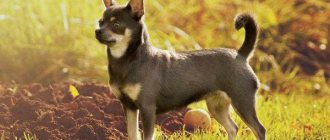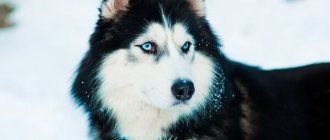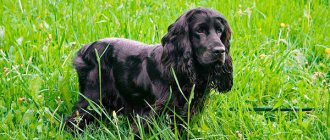Labrador Retrievers are gifted dogs with versatile skills and are used in the law enforcement agencies of countries, serving as guide dogs and being part of rescue teams around the world.
The word “retriever” is literally translated from English as “find and bring.”
A balanced psyche and unconditional love for people have become the hallmark of this breed, which began in the 1830s. laid by fishermen from St. John's, Fr. Newfoundland, who brought the ancestors of Labrador Retrievers to the UK.
History of appearance
After the fishermen from the island. Newfoundland brought the ancestors of Labrador retrievers to the islands of Great Britain, and the dogs quickly fell in love with the local residents. They swam beautifully and helped fishermen pull their nets ashore.
A new breed of Labrador Retriever was developed until the end of the 19th century. by mixing the blood of imported dogs with the blood of other retrievers and setters. This added to the hunting qualities of this breed.
In 1903, the English Kennel Club recognized Labradors as an independent breed for the first time. It is noteworthy that the first Labradors were exclusively black - fawn and chocolate colors were not recognized. And only 20 years later, in 1924. a fawn color was recorded, and even later a chocolate color.
Expert opinion
Kozhevin Semyon Kirillovich
Expert dog handler.
Labrador Retrievers should not be shy or afraid of people. Labradors are naturally curious, sociable and cheerful. When it comes to choosing a show breeding black Labrador, simply matching all the exterior qualities is not enough - special attention should be paid to the puppy’s mother (preferably, she has champion titles and is liked by type and temperament). When standing, the Black Labrador puppy should be compact with rounded ribs and good angulation of the limbs, the ribs should be palpable but not visualized. When looking at the dog from above, the body should resemble a barrel.
Purpose
According to sources, dogs used to help fishermen get nets out of the water. They are really very strong and can swim. Now they are used to help disabled people as guide dogs. Labradors are excellent detectives and rescuers. Security qualities are weakly expressed, because the animals are very friendly. If a stranger wants to play with a pet, he will only be happy.
Character traits
The character of a black Labrador is no different from the character of a fawn or chocolate Labrador - coat color does not in any way affect the temperament and behavior of Labradors.
Black dogs, despite their more menacing appearance due to their color (people who do not understand dog breeds often confuse them with Rottweilers), are just as friendly and open to all living things as fawn dogs. They, like Labradors of other colors, remain puppies (experts say that Labradors mature psychologically only at the age of three), while maintaining a curious, perky and cheerful disposition throughout their lives.
Possessing an excellent sense of smell, they swim and dive with pleasure.
Labradors love children very much and leaving even the smallest child in the room with a Labrador is not scary. The baby can crawl on it, ruffle its ears, pull its tail, but the most that a Labrador will do in such situations is to move aside. Labradors are distinguished by an excellent balanced psyche - nothing can piss them off and force them to bite a person or otherwise harm him.
They are smart and obedient, easy to train (7th place in the ranking of dogs according to their ability to train by Stanley Coren), confident in their abilities, persistent in achieving goals, always ready to please a person and experiencing great joy from contact with him. All of these personality traits combine to make the Labrador Retriever an ideal family dog. In the family they do not single out one person, but love all its members equally.
NOTE!
Their hunting qualities, together with a remarkable visual memory and the ability to retain in their mind the places where several birds fell at once, make them almost ready-made companions for hunters.
Description of the breed
The photo of the Labrador Retriever shows that the breed is particularly strong and has a rather powerful build. The eyes of a Labrador are brightly defined. The paws are strong, the head is wide. The body shape resembles a square.
The Labrador's tail is not docked; it is quite dense and thick and is an extension of the back. The wool is medium length and waterproof.
The dog weighs on average from 30 to 40 centimeters, height at the withers reaches up to 55 centimeters. Due to its parameters, it may appear taller and larger than it actually is.
The Labrador is a single color. There are black, fawn and chocolate dogs.
Advantages and disadvantages
The advantages of the breed are:
- low maintenance (no haircut or clothing required);
- calm, balanced character;
- easy to train (suitable even for novice dog breeders);
- bark a little;
- are not aggressive towards other animals and get along well with cats and other living creatures;
- Despite their large size, they are suitable for apartment living, subject to regular and active walks for at least 2 hours a day.
Speaking about Labradors, it is difficult to name their shortcomings, because the disadvantages of this breed are most likely the result of the incorrect behavior of their owners.
And yet, you can try to streamline those negative aspects that are attributed to Labradors and figure out how critical this is:
- Tendency to chew: Dogs of this breed, especially puppies, really like to chew things. This trait can be corrected by devoting sufficient time to the dog (they chew mainly when no one is home, because they are highly dependent on humans and experience stress due to the long absence of their owners) and actively walking the pet, during which it will throw out all the accumulated energy and he will no longer want to be active at home.
- They do not know how to protect and protect. Yes. Labradors are not protectors or guards, but if for some this is a minus, then for others it is a definite plus. A breed that does not have the aggression gene and is culled for this trait is not intended for protection, but for other purposes. This is a companion dog, the only breed that serves as a guide dog for the visually impaired. Those who need a guard get a different breed.
- Labradors are too trusting and will follow anyone they meet. Again, this is not a minus, but a feature of the breed. They were bred like dogs used in hunting game, when often several people go hunting at once: they must trust all people, not just the owner. And if suddenly the owner, for example, twists his leg and cannot walk further, he must continue his work and bring the shot bird to another hunter, thereby obtaining food for the family. If we talk about the modern world, then Labradors can be safely left for foster care without worrying that the dog will be very stressed. Therefore, the question of the gullibility of the breed is, again, a question of taste and the purpose of owning a dog.
- Labradors are susceptible to food allergies. Perhaps this is the only real disadvantage of the breed, which often really creates a problem for the owners, which, however, is quite possible to solve. Fawn Labradors are more prone to allergies; black Labradors suffer from it less. However, such a problem exists and you just need to intelligently and carefully approach the issue of nutrition and choose the right food or natural food, while excluding foods that are not suitable for this breed (mainly chicken and various cereals).
As you can see, this beautiful breed has many more advantages than disadvantages, and even those can be solved if desired.
Dimensions, weight and photos of dogs
Main characteristics of the black Labrador:
| Characteristics | Description |
| Adult dog height | 54-57 cm |
| Adult dog weight | 25-40 kg |
| Color | Solid black (resin), white breast option allowed. No other color variations are acceptable in black Labradors: black with mottled spots or tan is considered a disqualifying fault. |
| Wool | Short, dense, hard to the touch, with undercoat. The longhaired Labrador is considered a breeding match. |
| Tail | Very thick at the base, tapering towards the end, evenly covered with thick hair. Can wave happily, but should not curl over its back |
| Torso | Strong build, strong bones |
Also, although the external black color of Labradors is absolutely the same, genetically dogs can carry different colors:
- pure black;
- black and white;
- black, carrying chocolate;
- black carrying fawn;
- black, chocolate-bearing and fawn.
Feeding Labradors
An adult dog needs to be fed twice a day. Basically, dogs are fed meat, fish, porridge, milk and vegetable mixtures. Formulas are usually given in the morning, and meat products in the evening.
The serving size is determined individually. To do this, you need to watch the dog during feeding and decide whether it eats its portion or not.
Nutrition should be balanced and complete. It is prohibited to give sweet and salty foods to Labradors, including various sausages and sausages. You can buy ready-made dry or wet food and give it to your dog.
Life expectancy and illness
The lifespan of a black Labrador, like other Labradors, ranges from 10 to 14 years. As with people, this figure depends on the conditions and lifestyle, nutrition, individual characteristics of a particular individual and diseases to which the Labrador is susceptible and can fall ill.
The Labrador Retriever is a large dog and, first of all, often suffers from joint problems, elbow and knee dysplasia, and in old age, osteoarthritis. These diseases are directly related to the breed's tendency to gain excess weight, which over time puts unnecessary stress on the joints and skeletal system.
Heart and sugar problems are the second most common problems in Labradors.
Much in the physical condition and health of Labradors depends on their owners - if the pet is regularly given a sufficient amount of physical activity, monitors the intake of all necessary substances in its body, and does not overfeed, many health problems can be avoided as much as possible.
Nowadays, all responsible breeders test for dysplasia and other genetic diseases of their dogs before breeding to ensure healthy offspring free from these diseases.
IMPORTANT!
Unfortunately, Labradors are prone to developing cancer and this leads to deaths even among young dogs.
What affects color
Labradors remain a mystery to experts. It is quite difficult to guess the future colors of the offspring even if you know their pedigree. The puppy receives a pair of genes. A total of 9 combinations are formed. They determine the tone of a Labrador's coat.
- Pure black color is designated EEBB. With the inclusion of chocolate - EEBb. With fawn - EeBB. With two recessive genes - EeBb.
- Uniform fawn coat color - eeBB. With chocolate - eeBb. With weakened pigmentation - eebb.
- Brown - EEbb. With the fawn gene - Eebb.
In one litter, as a rule, there are puppies whose fur differs in different shades. There are cases where yellow or chocolate cubs are born from two black parents.
Basic rules of care
Caring for a Labrador will not be difficult and will not take much time or money.
- Wool . The first thing that speaks about the condition of a Labrador’s body is its coat. It should be shiny and growing evenly. Labradors do not need any haircuts; it is enough to comb them thoroughly twice a week (the best option for this is a special furminator comb, which combs out excess hair and undercoat without damaging the guard hair).
- Ears . About once every two weeks, the inside of the ears is wiped with a cotton swab soaked in a special lotion or regular chlorhexidine. The ears are also a kind of litmus test for a Labrador's health; they are often the first to signal a dog's allergic reaction to food.
- Paws . It is necessary to wash the paws daily and then wipe them dry, and in winter, when the animal’s toe pads are negatively affected by severe frosts and aggressive reagents, you need to treat them daily with a rich cream (it should be without fragrances and unnecessary additives, as natural as possible, because the pet can lick paws after the procedure: the most common baby cream or special veterinary cream “Zorka” will do). Before a walk, it is useful to lubricate the paws with special wax; it can also be found in a pet store.
- Claws . Regular nail trimming is necessary for every dog. Claws are trimmed as needed at the veterinarian or independently with a special nail clipper (sold in pet stores, there are different sizes depending on the size of the dog and different types: guillotine, sickle-shaped). When trimming nails yourself, you need to act very carefully: dogs have blood vessels in their nails and, in order not to damage them, the very tip is cut off. In black Labradors, unlike fawn Labradors, the claws are black and the blood vessels are difficult to see, so you should not take risks if you do not have confidence in your knowledge and sufficient experience: it is better to consult a doctor.
- Teeth . It is necessary to ensure the absence of plaque and tartar. To do this, the dog is given chewable treats and toys to help clean the teeth. You can brush your teeth yourself with a special brush or take your pet to the veterinarian every six months to a year to have their teeth cleaned using professional equipment.
- Water treatments . Often you should not completely wash your dog, only if it is heavily soiled, and you can even wash it with Labrador shampoo 1-2 times a year, otherwise the special water-repellent impregnation of the coat will be washed off. For minor stains, wipe the dog with a wet cloth.
How puppies develop
The table provides information on the development of Labrador puppies by month:
| Age | Development | Height, cm | Weight, kg. |
| 1-15 day |
| 15-18 | 0,4-0,55 |
| from 15 days to 1 month |
| 23-23,5 | 3,4-3,8 |
| 2 months |
| 30-32,5 | 7-8 |
| 3 months |
| 39,5-42 | 12-14 |
| 4 months |
| 44-46 | 17-19 |
| 5 months |
| 48-51 | 21-22 |
| 6 months |
| 50-55 | 24-26 |
Popular nicknames
Many dog breeders name their pets based on their color.
Below are the most popular names for black Labradors:
- for a black boy : Hades, Bruno, Black, Blade, Bond, Boomer, Woland, Dark, Diesel, Moor, Neo, Nero, Noir, Onyx, Richie, Romeo, Swart, Sirius, Charlie;
- for a black girl : Bagheera, Bonnie, Bertha, Blackie, Verona, Vendetta, Karma, Lara, Infinity, Audrey, Panther, Tiara, Shadow.
Of course, the list is not limited to these names for boys and girls. Each owner decides for himself what to name his pet. The main thing to remember here is that the nickname suits the animal.
Price range
Prices for black Labradors with a properly issued puppy card vary around 40-60 thousand rubles.
NOTE!
Despite the fact that Labrador puppies are in high demand, there are enough Labrador kennels in Russia, the competition between them is high, so you can try to bargain with the breeder and get a small discount.
Training
Black Labradors are very smart, love their owner, so they are easy to train. They will be able to carry out almost any command, the main thing is to please the owner. Training should begin immediately after purchase. Make them interesting, varied, short.
The Labrador is very inquisitive, so during training he is distracted by everything that interests him. Try to remove any distracting objects from your sight during this period. With proper upbringing, you will have a great friend, companion, helper and just a family favorite.
How to choose a puppy?
First, you need to decide for what purpose the puppy is being purchased (breeding, exhibition work, just for the family) and find out which clubs or nurseries that are part of the RKF structure have litters with a puppy that previously meets the requirements.
When choosing a puppy, you need to focus on your intuition and the call of your heart, but also not forget about the characteristics that are unacceptable for a purebred Labrador:
- timidity;
- aggressiveness;
- continuous barking;
- inappropriate behavior;
- eyes with a predatory, evil expression;
- gross defects in the exterior: erect or semi-erect ears, malocclusion, umbilical/inguinal hernia, tail bent or curled over the back, large white spot on the chest or in other places (in black Labradors only a small white spot is allowed and only on the chest).
You can ask the breeder which puppies have what kind of character, and observe them yourself (usually the most active puppy tries to change the nipple offered to him for one more filled with milk). There is no need to rush when choosing a puppy, because he will be a member of the family for the next 10-14 years.
When choosing between a girl and a boy, it is worth considering for what purpose the puppy is purchased:
- if as just a pet, gender doesn’t really matter, except that the girl will be more flexible. However, having chosen a female, the owner should be prepared for the fact that his pet will be in heat. But at the same time, an adult male will be constantly in search of a female in heat;
- for breeding it is better to choose a black girl;
- For exhibitions, a boy is more suitable - usually males are more conforming than females.
"To me!"
This command should also be taught from the very first days of the puppy’s appearance. Every time you feed him and put the bowl down, call your pet by name, adding the command itself (for example: “Gray, come to me!”).
During walks, reinforce this command. When the puppy happily runs towards you, say “Come to me!” and give a treat.
If at first he doesn’t want to come, then sit down and clap your hands (such an action will arouse curiosity), call him, then give him a treat. Don't hit or punish your puppy if he does something wrong. When raising a Labrador, you need to achieve unconditional obedience. After which you can move on to training.



